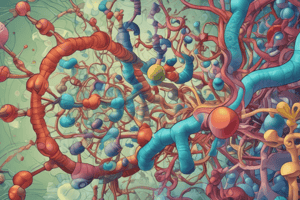Podcast
Questions and Answers
What is the difference between glucose and fructose?
What is the difference between glucose and fructose?
- They are both Ketose
- They are both Aldose
- They have the same molecular formula but differ in structure (correct)
- They have different molecular formulas
What is the classification of enantiomers based on?
What is the classification of enantiomers based on?
- The position of the –CH2OH group
- The position of the keto group
- The position of the –OH group attached to the carbon atom adjacent to the last –CH2OH (correct)
- The position of the anomeric carbon
What is the characteristic of enantiomers?
What is the characteristic of enantiomers?
- They have the same molecular formula but differ in structure
- They are mirror images of each other and superposable
- They are mirror images of each other and non-superposable (correct)
- They have different molecular formulas
What is the difference between D-glucose and D-mannose?
What is the difference between D-glucose and D-mannose?
What is the characteristic of epimers?
What is the characteristic of epimers?
What is the anomeric carbon?
What is the anomeric carbon?
What is the difference between α and β glucose?
What is the difference between α and β glucose?
What is the primary fuel for living cells?
What is the primary fuel for living cells?
Which of the following is NOT a type of stereoisomer?
Which of the following is NOT a type of stereoisomer?
Which of the following pairs of sugars are C4-epimers?
Which of the following pairs of sugars are C4-epimers?
Flashcards are hidden until you start studying
Study Notes
Carbohydrates
- Definition: Carbohydrates are biomolecules consisting of carbon, hydrogen, and oxygen atoms in the ratio Cn(H2O)n, literally a "carbon hydrate".
- Importance: Carbohydrates constitute about 60% of our diet and have extensive roles in all forms of life, including:
- Primary source of energy (e.g., glucose)
- Storage form of energy (e.g., glycogen)
- Biosynthesis of energy compounds, DNA, RNA, receptors, and vitamins
- Combining with lipids (glycolipids) or protein (glycoproteins) to form cell membrane structures
Classification of Carbohydrates
- Classified according to the number of sugar units:
- Monosaccharides: 1 sugar unit
- Disaccharides: 2 sugar units
- Oligosaccharides: 3-9 sugar units
- Polysaccharides: ≥10 sugar units
- Glucoconjugates: carbohydrate part + non-CHO part
Monosaccharides
- Definition: Simplest units of carbohydrates that cannot be broken down to smaller molecules by hydrolysis
- General formula: Cn(H2O)n
- Classified according to the number of carbon atoms:
- Trioses: 3 carbon atoms (e.g., glyceraldehyde, dihydroxyacetone)
- Tetroses: 4 carbon atoms (e.g., D-erythrose, erythrulose)
- Pentoses: 5 carbon atoms (e.g., D-ribose, deoxyribose, D-ribulose)
- Hexoses: 6 carbon atoms (e.g., D-glucose, D-mannose, D-galactose, fructose)
- Heptoses: 7 carbon atoms (e.g., D-sedoheptulose)
Structure of Monosaccharides
- Haworth Projection: Aldehyde or ketone reacts with OH group of C4 or C5 to form hemiacetal or hemiketal, creating a new asymmetric carbon called anomeric carbon (C1 or C2)
- Formation of cyclic ring: Five-membered ring (furanose) or six-membered ring (pyranose)
- α- and β-sugars: Depending on the arrangement of H and OH groups around carbon atoms
Asymmetric Carbon Atom (Chiral Carbon)
- Definition: Carbon atom attached to 4 different groups or atoms
- Properties: Optical activity and stereoisomerism
- Optical Activity: Ability to rotate plane polarized light either to the right (dextrorotatory) or to the left (levorotatory)
Isomerism
- Definition: Compounds with identical molecular formula but different structures or configurations
- Number of isomers: 2n, where n is the number of asymmetric carbon atoms
- Types of isomerism:
- Structural Isomers (Aldose-Ketose Isomerism)
- Stereoisomers (Enantiomers, Epimers, and Anomers)
Stereoisomers
- Enantiomers: Mirror images of each other, non-superposable, and classified into D and L forms
- Epimers: Sugar molecules that differ in configuration at only one of the chiral centers other than anomeric carbon
- Anomers: Isomers obtained from the change of position of hydroxyl attached to the anomeric carbon
Studying That Suits You
Use AI to generate personalized quizzes and flashcards to suit your learning preferences.




